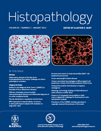Intramucosal variant of nasal natural killer (NK)/T cell lymphoma has a better survival than does invasive variant: implication on loss of E26 transformation-specific sequence 1 (ETS-1) and T-box expressed in T cells (T-bet) with invasion
Abstract
Lin T-C, Chen S-U, Chen Y-F, Chang Y-C & Lin C-W (2012) Histopathology 60, 287–295 Intramucosal variant of nasal natural killer (NK)/T cell lymphoma has a better survival than does invasive variant: implication on loss of E26 transformation-specific sequence 1 (ETS-1) and T-box expressed in T cells (T-bet) with invasion
Aims: Nasal natural killer/T cell lymphoma (NNKTCL) arises from the nasal mucosa, and spreads to adjacent tissues via local invasion or to regional lymph nodes and distant sites via metastasis. The aims of this study were to determine the impact of invasion on the prognosis of NNKTCL, and correlate invasion with the expression of cytotoxic markers of lymphoma cells.
Methods and results: Histopathological evaluations of invasion and immunohistochemistry for cytotoxic markers, including E26 transformation-specific sequence 1 (ETS-1), T-box expressed in T cells (T-bet), signal transducer and activator of transcription (STAT-1), CD56 and granzyme B (GB), were performed in 64 NNKTCLs. There were 17 stage I cases without invasion (stage Ia or intramucosal), 21 stage I cases with invasion (stage Ib), 16 stage II cases and 10 stages III/IV cases. Stage Ia NNKTCLs had a better 5-year overall survival rate than that of stages Ib, II or III/IV NNKTCLs (85%, 38%, 33% and 20%, respectively, P < 0.001 by log-rank test). Loss of ETS-1 was found in 24% (four of 17) stage Ia NNKTCLs and in 65% (28 of 43) stages Ib/II/III/IV NNKTCLs (P = 0.04, Fisher’s exact test); loss of T-bet was found in 29% (five of 17) stage Ia NNKTCLs and in 67% (30 of 45) stages Ib/II/III/IV NNKTCLs (P = 0.02, Fisher’s exact test).
Conclusions: NNKTCL is classically an aggressive lymphoma, but the intramucosal variant is less aggressive. Loss of ETS-1 or T-bet correlated weakly with invasion, a finding that requires further confirmation.




